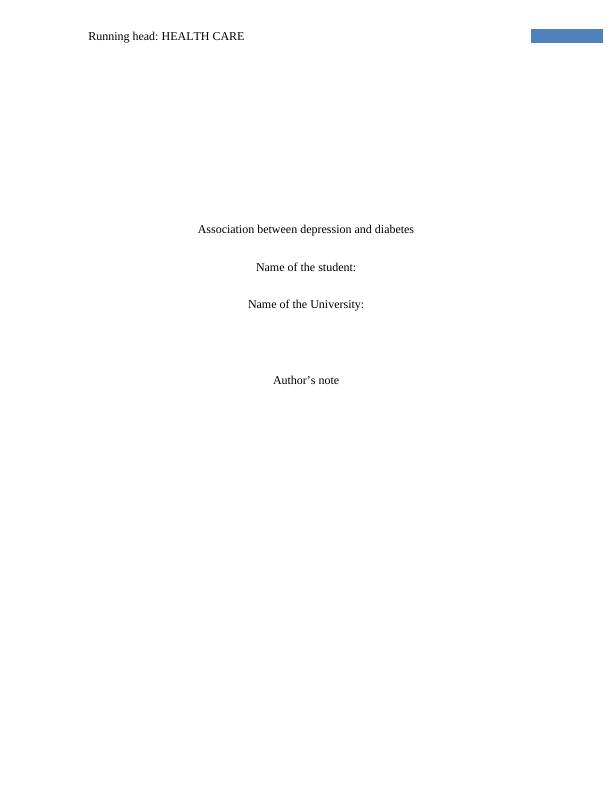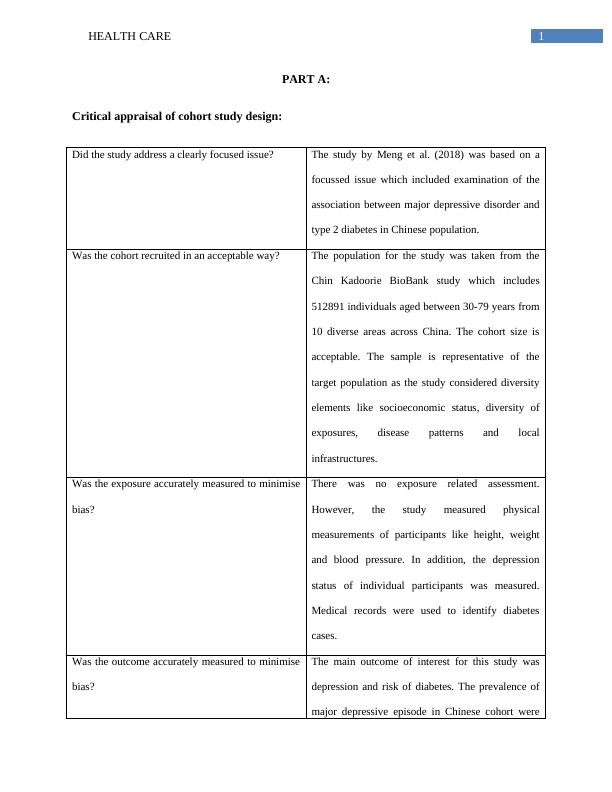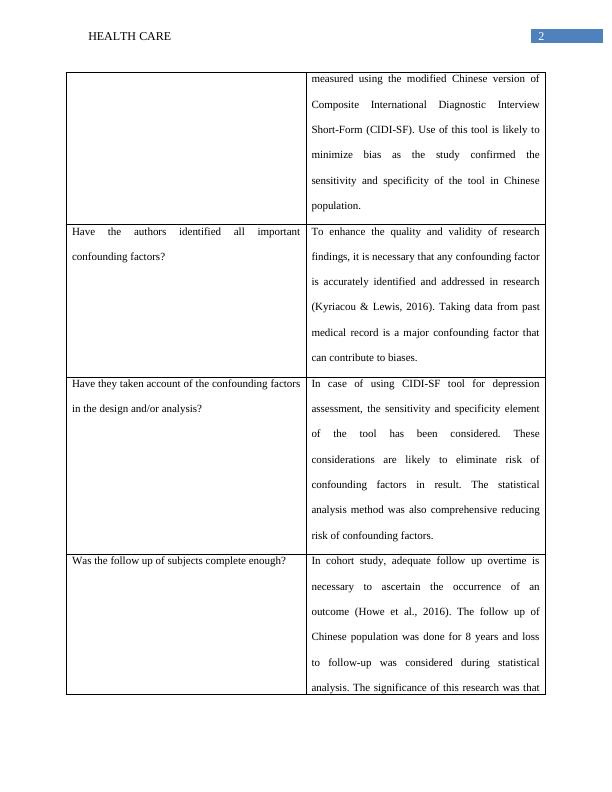Association between depression and diabetes
Added on 2023-01-23
12 Pages2489 Words74 Views
Running head: HEALTH CARE
Association between depression and diabetes
Name of the student:
Name of the University:
Author’s note
Association between depression and diabetes
Name of the student:
Name of the University:
Author’s note

1HEALTH CARE
PART A:
Critical appraisal of cohort study design:
Did the study address a clearly focused issue? The study by Meng et al. (2018) was based on a
focussed issue which included examination of the
association between major depressive disorder and
type 2 diabetes in Chinese population.
Was the cohort recruited in an acceptable way? The population for the study was taken from the
Chin Kadoorie BioBank study which includes
512891 individuals aged between 30-79 years from
10 diverse areas across China. The cohort size is
acceptable. The sample is representative of the
target population as the study considered diversity
elements like socioeconomic status, diversity of
exposures, disease patterns and local
infrastructures.
Was the exposure accurately measured to minimise
bias?
There was no exposure related assessment.
However, the study measured physical
measurements of participants like height, weight
and blood pressure. In addition, the depression
status of individual participants was measured.
Medical records were used to identify diabetes
cases.
Was the outcome accurately measured to minimise
bias?
The main outcome of interest for this study was
depression and risk of diabetes. The prevalence of
major depressive episode in Chinese cohort were
PART A:
Critical appraisal of cohort study design:
Did the study address a clearly focused issue? The study by Meng et al. (2018) was based on a
focussed issue which included examination of the
association between major depressive disorder and
type 2 diabetes in Chinese population.
Was the cohort recruited in an acceptable way? The population for the study was taken from the
Chin Kadoorie BioBank study which includes
512891 individuals aged between 30-79 years from
10 diverse areas across China. The cohort size is
acceptable. The sample is representative of the
target population as the study considered diversity
elements like socioeconomic status, diversity of
exposures, disease patterns and local
infrastructures.
Was the exposure accurately measured to minimise
bias?
There was no exposure related assessment.
However, the study measured physical
measurements of participants like height, weight
and blood pressure. In addition, the depression
status of individual participants was measured.
Medical records were used to identify diabetes
cases.
Was the outcome accurately measured to minimise
bias?
The main outcome of interest for this study was
depression and risk of diabetes. The prevalence of
major depressive episode in Chinese cohort were

2HEALTH CARE
measured using the modified Chinese version of
Composite International Diagnostic Interview
Short-Form (CIDI-SF). Use of this tool is likely to
minimize bias as the study confirmed the
sensitivity and specificity of the tool in Chinese
population.
Have the authors identified all important
confounding factors?
To enhance the quality and validity of research
findings, it is necessary that any confounding factor
is accurately identified and addressed in research
(Kyriacou & Lewis, 2016). Taking data from past
medical record is a major confounding factor that
can contribute to biases.
Have they taken account of the confounding factors
in the design and/or analysis?
In case of using CIDI-SF tool for depression
assessment, the sensitivity and specificity element
of the tool has been considered. These
considerations are likely to eliminate risk of
confounding factors in result. The statistical
analysis method was also comprehensive reducing
risk of confounding factors.
Was the follow up of subjects complete enough? In cohort study, adequate follow up overtime is
necessary to ascertain the occurrence of an
outcome (Howe et al., 2016). The follow up of
Chinese population was done for 8 years and loss
to follow-up was considered during statistical
analysis. The significance of this research was that
measured using the modified Chinese version of
Composite International Diagnostic Interview
Short-Form (CIDI-SF). Use of this tool is likely to
minimize bias as the study confirmed the
sensitivity and specificity of the tool in Chinese
population.
Have the authors identified all important
confounding factors?
To enhance the quality and validity of research
findings, it is necessary that any confounding factor
is accurately identified and addressed in research
(Kyriacou & Lewis, 2016). Taking data from past
medical record is a major confounding factor that
can contribute to biases.
Have they taken account of the confounding factors
in the design and/or analysis?
In case of using CIDI-SF tool for depression
assessment, the sensitivity and specificity element
of the tool has been considered. These
considerations are likely to eliminate risk of
confounding factors in result. The statistical
analysis method was also comprehensive reducing
risk of confounding factors.
Was the follow up of subjects complete enough? In cohort study, adequate follow up overtime is
necessary to ascertain the occurrence of an
outcome (Howe et al., 2016). The follow up of
Chinese population was done for 8 years and loss
to follow-up was considered during statistical
analysis. The significance of this research was that

3HEALTH CARE
there was high-follow up rate.
Was the follow up of subjects long enough? The follow-up of the cohort group was done for 8
years which is adequate time to interpret risk of
development of depression and diabetes in an
individual.
What are the results of this study? The statistical analysis of Chinese population data
from China Kadoorie Biobank study revealed that
major depressive episode is associated with
increased risk of type 2 diabetes. High rate of
incidence of type 2 diabetes was found for people
with depression compared to those without
depression. Hence, the research question was
addressed.
How precise are the results? . In case of participants with a depressive episode,
the risk of type 2 diabetes was 32% with CI 1.05–
1.68. Hence, the result was statistically significant
indicating the preciseness of the study findings.
Do you believe the results? Sensitivity aspect was considered for use of tools.
In addition, in case of review of diabetes cases
from medical record, the lab results were
reconfirmed. In addition, no loss-to-follow up cases
and long term-period of analysis enhanced the
validity of the study findings.
Can the results be applied to the local population? The findings cannot be applied to local population
because it was a prospective analysis and there is a
there was high-follow up rate.
Was the follow up of subjects long enough? The follow-up of the cohort group was done for 8
years which is adequate time to interpret risk of
development of depression and diabetes in an
individual.
What are the results of this study? The statistical analysis of Chinese population data
from China Kadoorie Biobank study revealed that
major depressive episode is associated with
increased risk of type 2 diabetes. High rate of
incidence of type 2 diabetes was found for people
with depression compared to those without
depression. Hence, the research question was
addressed.
How precise are the results? . In case of participants with a depressive episode,
the risk of type 2 diabetes was 32% with CI 1.05–
1.68. Hence, the result was statistically significant
indicating the preciseness of the study findings.
Do you believe the results? Sensitivity aspect was considered for use of tools.
In addition, in case of review of diabetes cases
from medical record, the lab results were
reconfirmed. In addition, no loss-to-follow up cases
and long term-period of analysis enhanced the
validity of the study findings.
Can the results be applied to the local population? The findings cannot be applied to local population
because it was a prospective analysis and there is a

End of preview
Want to access all the pages? Upload your documents or become a member.
Related Documents
Assignment about What is Cohort?lg...
|21
|3370
|26
Critical Appraisal of Review Articleslg...
|29
|3432
|48
Epidemiology Research Paper 2022lg...
|15
|4114
|15
Interpreting and Evaluating Health Evidencelg...
|10
|1836
|227
Research Methods - 25-hydroxyvitamin D and depressive symptomslg...
|5
|1433
|28
Sample Assignment on Epidemiologylg...
|10
|1463
|325
